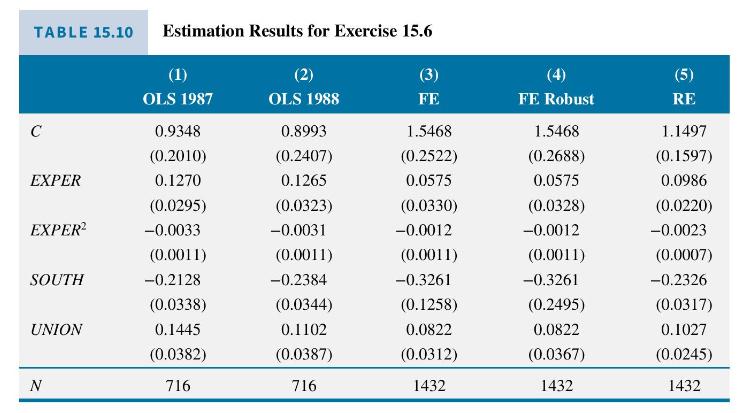Using the NLS panel data on (N=716) young women, we consider only years 1987 and 1988 .
Question:
Using the NLS panel data on \(N=716\) young women, we consider only years 1987 and 1988 . We are interested in the relationship between \(\ln (W A G E)\) and experience, its square, and indicator variables for living in the south and union membership. Some estimation results are in Table 15.10.

a. The OLS estimates of the \(\ln (W A G E)\) model for each of the years 1987 and 1988 are reported in columns (1) and (2). How do the results compare? For these individual year estimations, what are you assuming about the regression parameter values across individuals (heterogeneity)?
b. The \(\ln (W A G E)\) equation specified as a panel data regression model is

Explain any differences in assumptions between this model and the models in part (a).
c. Column (3) contains the estimated fixed effects model specified in part (b). Compare these estimates with the OLS estimates. Which coefficients, apart from the intercepts, show the most difference?
d. The \(F\)-statistic for the null hypothesis that there are no individual differences, equation (15.20), is 11.68. What are the degrees of freedom of the \(F\)-distribution if the null hypothesis (15.19) is true? What is the \(1 \%\) level of significance critical value for the test? What do you conclude about the null hypothesis.
e. Column (4) contains the fixed effects estimates with cluster-robust standard errors. In the context of this sample, explain the different assumptions you are making when you estimate with and without cluster-robust standard errors. Compare the standard errors with those in column (3). Which ones are substantially different? Are the robust ones larger or smaller?
f. Column (5) contains the random effects estimates. Which coefficients, apart from the intercepts, show the most difference from the fixed effects estimates? Use the Hausman test statistic (15.36) to test whether there are significant differences between the random effects estimates and the fixed effects estimates in column (3) (Why that one?). Based on the test results, is random effects estimation in this model appropriate?
Data From Equation 15.20:-

Step by Step Answer:

Principles Of Econometrics
ISBN: 9781118452271
5th Edition
Authors: R Carter Hill, William E Griffiths, Guay C Lim





